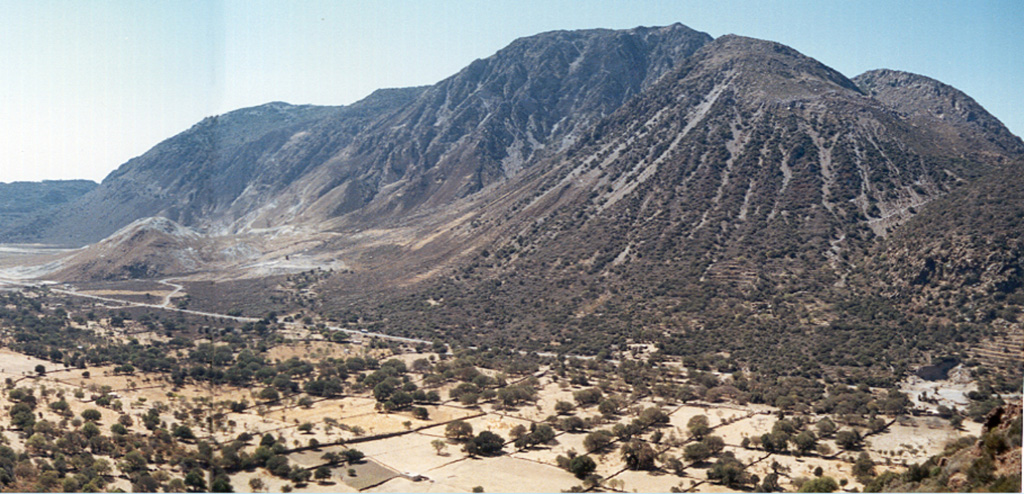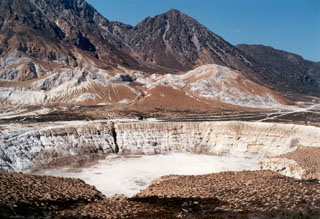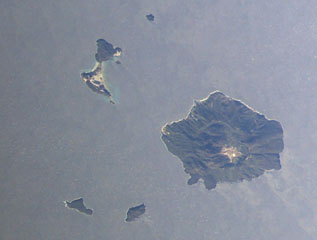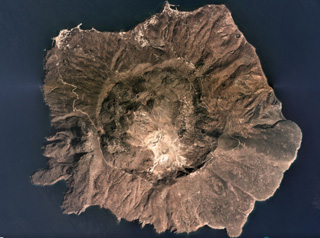Due to the US Government shutdown, the Smithsonian is temporarily closed. The Global Volcanism Program website will remain available but will not be monitored or updated. Status updates will be available on the Smithsonian homepage.



According to a news article, the crater of Nisyros was declared off limits to visitors, due to increasing temperatures and growing surface cracks. Evangelos Layios, the director of Athens University's geophysics laboratory, stated, ". . . earthquakes in 1995-96 triggered changes in the general condition of the volcano. For example, the hydrothermal system has increased in [temperature] from 210 to 315 degrees Celsius, there is continuous microseismic activity as well as changes on the surface of the ground." The ban on visitors was prompted by a crack on the volcano that almost tripled in length over the past year to 139 m.
Source: Kathimerini News
2003: January
According to a news article, the crater of Nisyros was declared off limits to visitors, due to increasing temperatures and growing surface cracks. Evangelos Layios, the director of Athens University's geophysics laboratory, stated, ". . . earthquakes in 1995-96 triggered changes in the general condition of the volcano. For example, the hydrothermal system has increased in [temperature] from 210 to 315 degrees Celsius, there is continuous microseismic activity as well as changes on the surface of the ground." The ban on visitors was prompted by a crack on the volcano that almost tripled in length over the past year to 139 m.
Source: Kathimerini News
The Global Volcanism Program has no Bulletin Reports available for Nisyros.
|
|
||||||||||||||||||||||||||
There is data available for 4 confirmed eruptive periods.
1888 Sep 25 ± 4 days Confirmed Eruption (Explosive / Effusive) VEI: 2
| Episode 1 | Eruption (Explosive / Effusive) | Polyvotis Micros | |||||||||||||||||||||||
|---|---|---|---|---|---|---|---|---|---|---|---|---|---|---|---|---|---|---|---|---|---|---|---|---|
| 1888 Sep 25 ± 4 days - Unknown | Evidence from Observations: Reported | |||||||||||||||||||||||
|
List of 3 Events for Episode 1 at Polyvotis Micros
|
||||||||||||||||||||||||
1873 Jun - 1873 Sep 26 Confirmed Eruption (Explosive / Effusive) VEI: 2
| Episode 1 | Eruption (Explosive / Effusive) | Plegathon and Polyvotis | ||||||||||||||||||||||||||||||||||||||||||||||||
|---|---|---|---|---|---|---|---|---|---|---|---|---|---|---|---|---|---|---|---|---|---|---|---|---|---|---|---|---|---|---|---|---|---|---|---|---|---|---|---|---|---|---|---|---|---|---|---|---|---|
| 1873 Jun - 1873 Sep 26 | Evidence from Observations: Reported | ||||||||||||||||||||||||||||||||||||||||||||||||
|
List of 8 Events for Episode 1 at Plegathon and Polyvotis
|
|||||||||||||||||||||||||||||||||||||||||||||||||
1871 Confirmed Eruption (Explosive / Effusive) VEI: 2
| Episode 1 | Eruption (Explosive / Effusive) | Plegathon and Polyvotis | |||||||||||||||||||||||||||||||||||||||||||
|---|---|---|---|---|---|---|---|---|---|---|---|---|---|---|---|---|---|---|---|---|---|---|---|---|---|---|---|---|---|---|---|---|---|---|---|---|---|---|---|---|---|---|---|---|
| 1871 - Unknown | Evidence from Observations: Reported | |||||||||||||||||||||||||||||||||||||||||||
|
List of 7 Events for Episode 1 at Plegathon and Polyvotis
|
||||||||||||||||||||||||||||||||||||||||||||
1422 Confirmed Eruption (Explosive / Effusive) VEI: 2
| Episode 1 | Eruption (Explosive / Effusive) | |||||||||||||||||||||||||||||
|---|---|---|---|---|---|---|---|---|---|---|---|---|---|---|---|---|---|---|---|---|---|---|---|---|---|---|---|---|---|
| 1422 - Unknown | Evidence from Observations: Reported | ||||||||||||||||||||||||||||
|
List of 4 Events for Episode 1
|
|||||||||||||||||||||||||||||
This compilation of synonyms and subsidiary features may not be comprehensive. Features are organized into four major categories: Cones, Craters, Domes, and Thermal Features. Synonyms of features appear indented below the primary name. In some cases additional feature type, elevation, or location details are provided.
Cones |
||||
| Feature Name | Feature Type | Elevation | Latitude | Longitude |
| Achelone | Vent | |||
| Acheolus | Vent | |||
| Agios Joannis | Vent | 588 m | ||
| Alexandros | Vent | |||
| Andreas | Vent | |||
| Kaminakia | Vent | |||
| Logothetis | Vent | |||
| Phlegethon | Vent | |||
| Polybotes | Vent | |||
| Polyvotis Megalos
Megalos Polybotes |
Vent | |||
| Polyvotis Micros
Mikros Polybotes Polybotes Micros Micros Polybotes |
Vent | |||
| Stefanos
Stephanos |
Vent | 110 m | ||
Domes |
||||
| Feature Name | Feature Type | Elevation | Latitude | Longitude |
| Boriatiko Vouno | Dome | |||
| Karaviotis | Dome | |||
| Kratioti | Dome | |||
| Lofos | Dome | |||
| Profitis Ilias
Profit Elias |
Dome | 698 m | ||
| Trapezina | Dome | |||
Thermal |
||||
| Feature Name | Feature Type | Elevation | Latitude | Longitude |
| Emborio | Thermal | |||
| Kailia | Thermal | |||
| Nikia | Thermal | |||
| Piria | Thermal | |||
 The tuff cone and crater in the foreground were formed during an eruption on the caldera floor in 1871. Phreatic explosions ejected ash and lapilli that covered the caldera floor. Five explosion craters are located in the 800 x 1,400 m caldera floor. Post-caldera lava domes form the horizon.
The tuff cone and crater in the foreground were formed during an eruption on the caldera floor in 1871. Phreatic explosions ejected ash and lapilli that covered the caldera floor. Five explosion craters are located in the 800 x 1,400 m caldera floor. Post-caldera lava domes form the horizon. The Mount Hagi Ilias lava dome occupies the western side of a 3-4 km wide caldera at the summit of Nisyros volcano, the easternmost of the Aegean arc. Five large post-caldera lava domes completely fill the western part of the caldera. Historical phreatic eruptions occurred within the caldera between 1422 and 1888.
The Mount Hagi Ilias lava dome occupies the western side of a 3-4 km wide caldera at the summit of Nisyros volcano, the easternmost of the Aegean arc. Five large post-caldera lava domes completely fill the western part of the caldera. Historical phreatic eruptions occurred within the caldera between 1422 and 1888. The island of Yali (upper left) and the island of Nisyros Island (lower right) are shown this NASA International Space Station image (with N to the upper left). Yali contains two distinct segments connected by a narrow isthmus formed of modern reef sediments and consists of rhyolitic obsidian domes at the NE end and pumice-fall deposits at the SW end. A caldera 3-4 km wide, much of the W side of which is filled by post-collapse lava domes, is visible on Nisyros Island.
The island of Yali (upper left) and the island of Nisyros Island (lower right) are shown this NASA International Space Station image (with N to the upper left). Yali contains two distinct segments connected by a narrow isthmus formed of modern reef sediments and consists of rhyolitic obsidian domes at the NE end and pumice-fall deposits at the SW end. A caldera 3-4 km wide, much of the W side of which is filled by post-collapse lava domes, is visible on Nisyros Island. Nisyros has a 3.6-km-diameter caldera with walls 300-400 m high and is filled with lava domes, seen here in this September 2019 Planet Labs satellite image monthly mosaic (N is at the top). The edifice also has vents, scoria cones, dikes, fault systems, and geothermal features, including active fumaroles and hot springs.
Nisyros has a 3.6-km-diameter caldera with walls 300-400 m high and is filled with lava domes, seen here in this September 2019 Planet Labs satellite image monthly mosaic (N is at the top). The edifice also has vents, scoria cones, dikes, fault systems, and geothermal features, including active fumaroles and hot springs.There are no samples for Nisyros in the Smithsonian's NMNH Department of Mineral Sciences Rock and Ore collection.
| Copernicus Browser | The Copernicus Browser replaced the Sentinel Hub Playground browser in 2023, to provide access to Earth observation archives from the Copernicus Data Space Ecosystem, the main distribution platform for data from the EU Copernicus missions. |
| MIROVA | Middle InfraRed Observation of Volcanic Activity (MIROVA) is a near real time volcanic hot-spot detection system based on the analysis of MODIS (Moderate Resolution Imaging Spectroradiometer) data. In particular, MIROVA uses the Middle InfraRed Radiation (MIR), measured over target volcanoes, in order to detect, locate and measure the heat radiation sourced from volcanic activity. |
| MODVOLC Thermal Alerts | Using infrared satellite Moderate Resolution Imaging Spectroradiometer (MODIS) data, scientists at the Hawai'i Institute of Geophysics and Planetology, University of Hawai'i, developed an automated system called MODVOLC to map thermal hot-spots in near real time. For each MODIS image, the algorithm automatically scans each 1 km pixel within it to check for high-temperature hot-spots. When one is found the date, time, location, and intensity are recorded. MODIS looks at every square km of the Earth every 48 hours, once during the day and once during the night, and the presence of two MODIS sensors in space allows at least four hot-spot observations every two days. Each day updated global maps are compiled to display the locations of all hot spots detected in the previous 24 hours. There is a drop-down list with volcano names which allow users to 'zoom-in' and examine the distribution of hot-spots at a variety of spatial scales. |
|
WOVOdat
Single Volcano View Temporal Evolution of Unrest Side by Side Volcanoes |
WOVOdat is a database of volcanic unrest; instrumentally and visually recorded changes in seismicity, ground deformation, gas emission, and other parameters from their normal baselines. It is sponsored by the World Organization of Volcano Observatories (WOVO) and presently hosted at the Earth Observatory of Singapore.
GVMID Data on Volcano Monitoring Infrastructure The Global Volcano Monitoring Infrastructure Database GVMID, is aimed at documenting and improving capabilities of volcano monitoring from the ground and space. GVMID should provide a snapshot and baseline view of the techniques and instrumentation that are in place at various volcanoes, which can be use by volcano observatories as reference to setup new monitoring system or improving networks at a specific volcano. These data will allow identification of what monitoring gaps exist, which can be then targeted by remote sensing infrastructure and future instrument deployments. |
| Volcanic Hazard Maps | The IAVCEI Commission on Volcanic Hazards and Risk has a Volcanic Hazard Maps database designed to serve as a resource for hazard mappers (or other interested parties) to explore how common issues in hazard map development have been addressed at different volcanoes, in different countries, for different hazards, and for different intended audiences. In addition to the comprehensive, searchable Volcanic Hazard Maps Database, this website contains information about diversity of volcanic hazard maps, illustrated using examples from the database. This site is for educational purposes related to volcanic hazard maps. Hazard maps found on this website should not be used for emergency purposes. For the most recent, official hazard map for a particular volcano, please seek out the proper institutional authorities on the matter. |
| IRIS seismic stations/networks | Incorporated Research Institutions for Seismology (IRIS) Data Services map showing the location of seismic stations from all available networks (permanent or temporary) within a radius of 0.18° (about 20 km at mid-latitudes) from the given location of Nisyros. Users can customize a variety of filters and options in the left panel. Note that if there are no stations are known the map will default to show the entire world with a "No data matched request" error notice. |
| UNAVCO GPS/GNSS stations | Geodetic Data Services map from UNAVCO showing the location of GPS/GNSS stations from all available networks (permanent or temporary) within a radius of 20 km from the given location of Nisyros. Users can customize the data search based on station or network names, location, and time window. Requires Adobe Flash Player. |
| DECADE Data | The DECADE portal, still in the developmental stage, serves as an example of the proposed interoperability between The Smithsonian Institution's Global Volcanism Program, the Mapping Gas Emissions (MaGa) Database, and the EarthChem Geochemical Portal. The Deep Earth Carbon Degassing (DECADE) initiative seeks to use new and established technologies to determine accurate global fluxes of volcanic CO2 to the atmosphere, but installing CO2 monitoring networks on 20 of the world's 150 most actively degassing volcanoes. The group uses related laboratory-based studies (direct gas sampling and analysis, melt inclusions) to provide new data for direct degassing of deep earth carbon to the atmosphere. |
| Large Eruptions of Nisyros | Information about large Quaternary eruptions (VEI >= 4) is cataloged in the Large Magnitude Explosive Volcanic Eruptions (LaMEVE) database of the Volcano Global Risk Identification and Analysis Project (VOGRIPA). |
| EarthChem | EarthChem develops and maintains databases, software, and services that support the preservation, discovery, access and analysis of geochemical data, and facilitate their integration with the broad array of other available earth science parameters. EarthChem is operated by a joint team of disciplinary scientists, data scientists, data managers and information technology developers who are part of the NSF-funded data facility Integrated Earth Data Applications (IEDA). IEDA is a collaborative effort of EarthChem and the Marine Geoscience Data System (MGDS). |